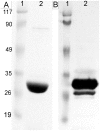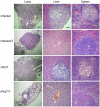Additive effect of rPb27 immunization and chemotherapy in experimental paracoccidioidomycosis
- PMID: 21423771
- PMCID: PMC3053394
- DOI: 10.1371/journal.pone.0017885
Additive effect of rPb27 immunization and chemotherapy in experimental paracoccidioidomycosis
Abstract
Paracoccidioidomycosis, PCM, the major systemic mycosis in Latin America, is caused by the termally dimorphic fungus Paracoccidioides brasiliensis and requires extended periods of chemotherapy with a significant frequency of relapsing disease. The search for new alternatives of treatment is necessary. rPb27 is an antigenic protein from P. brasiliensis that already showed a significant protective activity as a vaccine for PCM in experimental models. The cDNA of rPb27 was subcloned into a pET-DEST 42 plasmid, expressed in E. coli with a his-tag and purified by affinity chromatography. Immunization with this recombinant protein and chemotherapy were used together in an attempt to improve treatment of PCM. For this, BALB/c mice were challenged with pathogenic P. brasiliensis strain and after immunized with rPb27, in the presence of Corynebacterium parvum and Al(OH)(3), some groups were also treated with fluconazole. After 40 days of treatment, the combined drug/rPb27 administration controlled PCM in the liver and spleen, with long lasting protection, and largely preserved tissues structures of these organs. Additionally, in the lungs after 40 days of treatment there was a significant reduction in the fungal load and size of lesions. At the same time, the levels of TNF-α were higher than infected-only mice. Moreover, significant levels of anti-rPb27 specific IgG1, IgG2a and IgG2b isotypes were detected in the sera of mice immunized with rPb27 fluconazole treated or not. These results showed an additive protective effect of rPb27 immunization and chemotherapy, suggesting that an rPb27-based vaccine can be used to enhance PCM antifungal treatment.
Conflict of interest statement
Figures






Similar articles
-
Immunization with recombinant Pb27 protein reduces the levels of pulmonary fibrosis caused by the inflammatory response against Paracoccidioides brasiliensis.Mycopathologia. 2015 Feb;179(1-2):31-43. doi: 10.1007/s11046-014-9815-8. Epub 2014 Dec 9. Mycopathologia. 2015. PMID: 25487973
-
The combined use of Paracoccidioides brasiliensis Pb40 and Pb27 recombinant proteins enhances chemotherapy effects in experimental paracoccidioidomycosis.Microbes Infect. 2011 Nov;13(12-13):1062-72. doi: 10.1016/j.micinf.2011.06.004. Epub 2011 Jun 21. Microbes Infect. 2011. PMID: 21726659
-
Protective immunity induced by rPb27 of Paracoccidioides brasiliensis.Vaccine. 2008 Oct 9;26(43):5461-9. doi: 10.1016/j.vaccine.2008.07.097. Epub 2008 Aug 21. Vaccine. 2008. PMID: 18722494
-
Attempts at a peptide vaccine against paracoccidioidomycosis, adjuvant to chemotherapy.Mycopathologia. 2008 Apr-May;165(4-5):341-52. doi: 10.1007/s11046-007-9056-1. Mycopathologia. 2008. PMID: 18777638 Review.
-
PARACOCCIDIOIDOMYCOSIS: CHALLENGES IN THE DEVELOPMENT OF A VACCINE AGAINST AN ENDEMIC MYCOSIS IN THE AMERICAS.Rev Inst Med Trop Sao Paulo. 2015 Sep;57 Suppl 19(Suppl 19):21-4. doi: 10.1590/S0036-46652015000700005. Rev Inst Med Trop Sao Paulo. 2015. PMID: 26465365 Free PMC article. Review.
Cited by
-
Fungal Vaccine Development: State of the Art and Perspectives Using Immunoinformatics.J Fungi (Basel). 2023 May 31;9(6):633. doi: 10.3390/jof9060633. J Fungi (Basel). 2023. PMID: 37367569 Free PMC article. Review.
-
Detrimental Effect of Fungal 60-kDa Heat Shock Protein on Experimental Paracoccidioides brasiliensis Infection.PLoS One. 2016 Sep 6;11(9):e0162486. doi: 10.1371/journal.pone.0162486. eCollection 2016. PLoS One. 2016. PMID: 27598463 Free PMC article.
-
Immunization with recombinant Pb27 protein reduces the levels of pulmonary fibrosis caused by the inflammatory response against Paracoccidioides brasiliensis.Mycopathologia. 2015 Feb;179(1-2):31-43. doi: 10.1007/s11046-014-9815-8. Epub 2014 Dec 9. Mycopathologia. 2015. PMID: 25487973
-
Antifungal Activity of Amphotericin B Conjugated to Nanosized Magnetite in the Treatment of Paracoccidioidomycosis.PLoS Negl Trop Dis. 2016 Jun 15;10(6):e0004754. doi: 10.1371/journal.pntd.0004754. eCollection 2016 Jun. PLoS Negl Trop Dis. 2016. PMID: 27303789 Free PMC article.
-
Challenges in Serologic Diagnostics of Neglected Human Systemic Mycoses: An Overview on Characterization of New Targets.Pathogens. 2022 May 11;11(5):569. doi: 10.3390/pathogens11050569. Pathogens. 2022. PMID: 35631090 Free PMC article. Review.
References
-
- Visbal G, San-Blas G, Murgich J, Franco H. Paracoccidioides brasiliensis, paracoccidioidomycosis, and antifungal antibiotics. Curr Drug Targets Infect Disord. 2005;5:211–226. - PubMed
-
- Odds FC, Brown AJ, Gow NA. Antifungal agents: mechanisms of action. Trends Microbiol. 2003;11:272–279. - PubMed
-
- San-Blas G, Nino-Vega G. Paracoccidioides brasiliensis: chemical and molecular tools for research on cell walls, antifungals, diagnosis, taxonomy. Mycopathologia. 2008;165:183–195. - PubMed
-
- Hahn RC, Morato Conceicao YT, Santos NL, Ferreira JF, Hamdan JS. Disseminated paracoccidioidomycosis: correlation between clinical and in vitro resistance to ketoconazole and trimethoprim sulphamethoxazole. Mycoses. 2003;46:342–347. - PubMed
-
- Pereira RM, Bucaretchi F, Barison Ede M, Hessel G, Tresoldi AT. Paracoccidioidomycosis in children: clinical presentation, follow-up and outcome. Rev Inst Med Trop Sao Paulo. 2004;46:127–131. - PubMed
Publication types
MeSH terms
Substances
LinkOut - more resources
Full Text Sources
Medical

